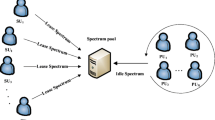Abstract
Due to its scarce nature, the limited frequency spectrum must be effectively allocated to competing wireless access technologies. A promising approach is to consider frequency spectrum as a commodity and model the spectrum allocation as a market dynamics problem. Using this approach, we have addressed the competition for frequency spectrum by e.g. 3G and 4G technologies where network operators, users and the regulatory agent are the market players. We have modeled the system dynamics as a novel three-stage game creating a unified framework for spectrum allocation, network best response and user welfare. By finding the Nash equilibrium of the game, the influence of regulatory decisions and impact of network/user strategies is analyzed. Through the interaction of networks and users and influence exerted by the regulatory, the resulting spectrum allocations are proved to be Pareto efficient with maximal social welfare. The devised model and following results provides a much needed and important framework for the regulatory and network operators for adjusting spectrum allocation table towards maximizing the social welfare for all the players.

















Similar content being viewed by others
References
Zhang, W. (2005). Bearer service allocation and pricing in heterogeneous wireless networks. In IEEE international conference on communications (ICC 2005).
Chan, H., Fan, P., & Cao, Z. (2005). A utility-based network selection scheme for multiple services in heterogeneous networks. In 2005 International conference on wireless networks, communications and mobile computing.
Kelly, F. P., Maulloo, A. K., & Tan, D. K. (1998). Rate control for communication networks: Shadow prices, proportional fairness and stability. Journal of the Operational Research Society, 49(3), 237–252.
Sallent, O., Pérez-Romero, J., Agusti, R., Giupponi, L., Kloeck, C., Martoyo, I., Klett, S., & Luo, J. (2006). Resource auctioning mechanisms in heterogeneous wireless access networks. In Vehicular technology conference, 2006. VTC 2006-Spring. IEEE 63rd.
Niyato, D., & Hossain, E. (2008). Competitive pricing in heterogeneous wireless access networks: Issues and approaches. IEEE Network, 22(6), 4–11.
Haghighatdoost, V., & Khorsandi, S. (2017). Mechanism design for pricing and bandwidth allocation in heterogeneous wireless networks to maximize the social welfare. In 9th International conference on information and knowledge technology (IKT), Tehran.
Matinkhah, S. M., Khorsandi, S., & Yarahmadian, S. (2017). A load balancing system for autonomous connection management in heterogeneous wireless networks. Computer Communications, 97, 111–119.
Matinkhah, S. M., & Khorsandi, S. (2012). Using data envelopment analysis for base station selection in heterogeneous wireless access networks. In 2012 Sixth international symposium on telecommunications (IST) (pp. 766–770).
Duan, L., Huang, J., & Shou, B. (2012). Duopoly competition in dynamic spectrum leasing and pricing. IEEE Transactions on Mobile Computing, 11(11), 1706–1719.
Chen, Y., Duan, L., Huang, J., & Zhang, Q. (2015). Balancing income and user utility in spectrum allocation. IEEE Transactions on Mobile Computing, 14, 2460–2473.
Jia, J., Zhang, Q., Zhang, Q., & Liu, M. (2009). Revenue generation for truthful spectrum auction in dynamic spectrum access. In Proceedings of the tenth ACM international symposium on mobile ad hoc networking and computing.
Wang, W., Liang, B., & Li, B. (2014). Designing truthful spectrum double auctions with local markets. IEEE Transactions on Mobile Computing, 13(1), 75–88.
Dong, M., Sun, G., Wang, X., & Zhang, Q. (2012). Combinatorial auction with time-frequency flexibility in cognitive radio networks. In INFOCOM, 2012 Proceedings IEEE.
Ribeiro, A., Medeiros, N., & Cota, N. (2014). Comparison of GSM, WCDMA and LTE performance on 900 MHz band. Procedia Technology, 17, 674–682.
Osborne, M. J. (2004). An introduction to game theory (Vol. 3). New York: Oxford University Press.
Author information
Authors and Affiliations
Corresponding author
Additional information
Publisher's Note
Springer Nature remains neutral with regard to jurisdictional claims in published maps and institutional affiliations.
Rights and permissions
About this article
Cite this article
Haghighatdoost, V., Khorsandi, S. Game theoretic spectrum allocation for competing wireless access technologies to maximize the social welfare. Wireless Netw 25, 3557–3577 (2019). https://doi.org/10.1007/s11276-019-01952-5
Published:
Issue Date:
DOI: https://doi.org/10.1007/s11276-019-01952-5




